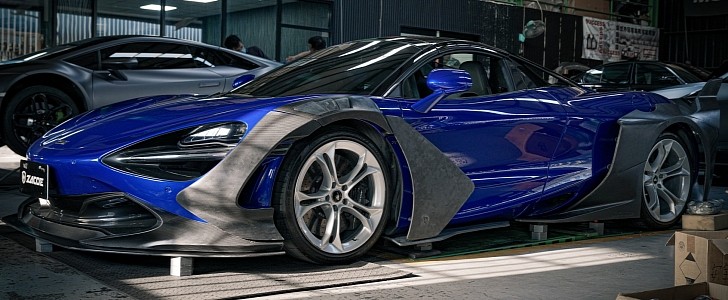To you and me, the McLaren 720S is perfect and doesn’t need any wacky upgrades in order to stand out even more. But certain owners of the British supercar do feel the need to personalize theirs, and it is them who are being targeted by Zacoe with a new body kit.
A rather extreme proposal for the 720S, the upgrade takes inspiration from the Senna and will be available “very soon,” the tuner claims in a social media post that shows several real-life images of the supercar sporting the kit. A quick look on the official website reveals the finished project, in a different shade, which seems ready to dominate local car meets.
So, what exactly is new? That would be the big chin spoiler and the redesigned air intakes in the front bumper. Featuring louvers likely to improve the aerodynamics, the wheel arches are much fatter than before, and so are their extensions around the side skirts. A new diffuser, with a much more aggressive design, is included, too, next to a large rear wing that is attached to the extended rear wheel arches.
Finished in yellow, and contrasted by the carbon fiber add-ons, the tuned 720S in question rides on new wheels that spin around the yellow brake calipers. They were shod in thin yet sticky tires and fill the arches just perfectly. Zacoe hasn’t said anything else about the build, but it appears that it sits a bit closer to the ground compared to the stock offering, so it might feature an adjustable air suspension, too.
Pushing out 710 hp (720 ps / 530 kW) and 568 lb-ft (770 Nm) of torque with no outside intervention, the twin-turbocharged 4.0-liter V8 has likely remained stock. It works in concert with a seven-speed automatic transmission that transfers the thrust to the rear axle, enabling a 0 to 62 mph (0-100 kph) in 2.9 seconds and a 212 mph (341 kph) top speed.
So, what exactly is new? That would be the big chin spoiler and the redesigned air intakes in the front bumper. Featuring louvers likely to improve the aerodynamics, the wheel arches are much fatter than before, and so are their extensions around the side skirts. A new diffuser, with a much more aggressive design, is included, too, next to a large rear wing that is attached to the extended rear wheel arches.
Finished in yellow, and contrasted by the carbon fiber add-ons, the tuned 720S in question rides on new wheels that spin around the yellow brake calipers. They were shod in thin yet sticky tires and fill the arches just perfectly. Zacoe hasn’t said anything else about the build, but it appears that it sits a bit closer to the ground compared to the stock offering, so it might feature an adjustable air suspension, too.
Pushing out 710 hp (720 ps / 530 kW) and 568 lb-ft (770 Nm) of torque with no outside intervention, the twin-turbocharged 4.0-liter V8 has likely remained stock. It works in concert with a seven-speed automatic transmission that transfers the thrust to the rear axle, enabling a 0 to 62 mph (0-100 kph) in 2.9 seconds and a 212 mph (341 kph) top speed.



















